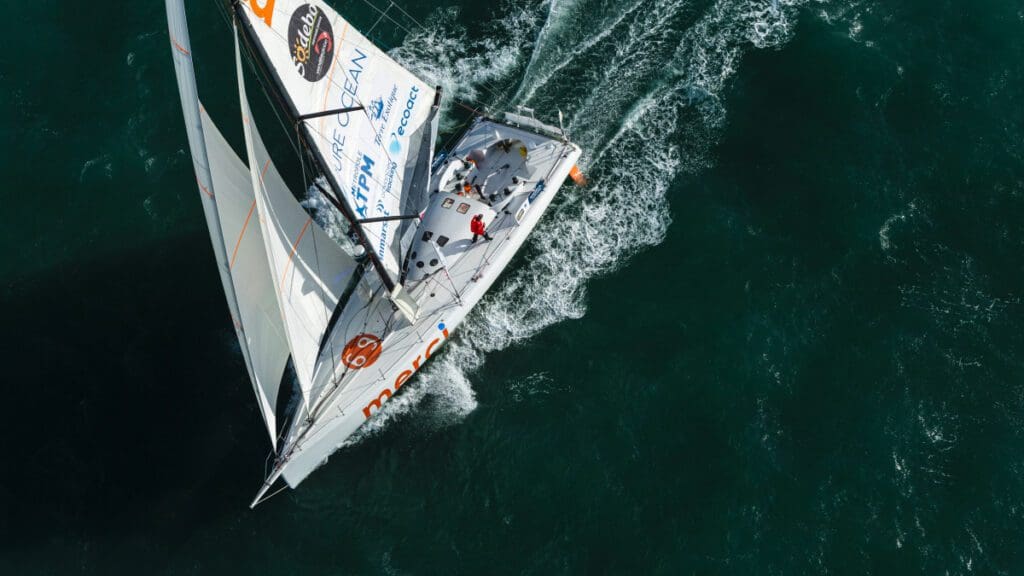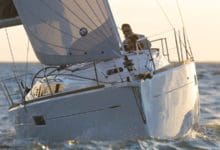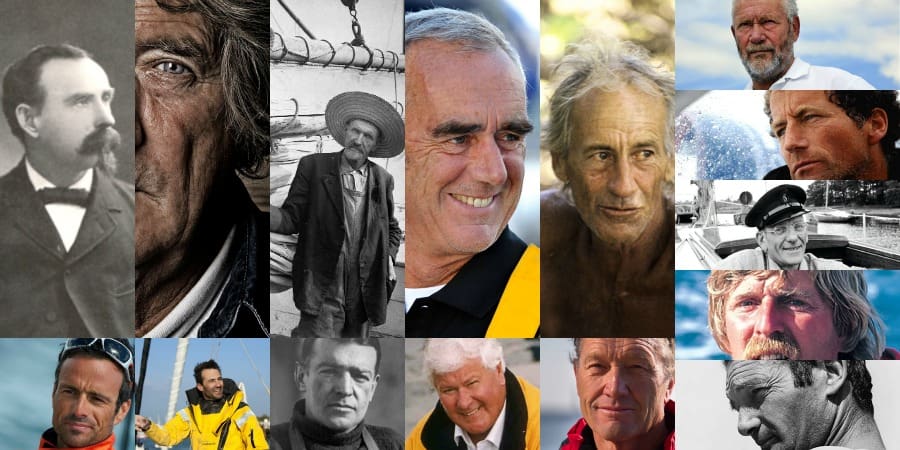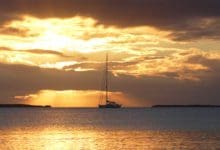
The latest generation of IMOCA technology will surely deliver a new Vendée Globe record time. The British skipper of Hugo Boss, Alex Thomson, suggested on Tuesday in Les Sables d’Olonne that a new time could be “between 59 and 70 days depending on the weather”. Armel Le Cléac’h, the winner of the 2016-17 edition, took 74 days to complete his winning lap of the planet. Since the last Vendée Globe, speeds on all points of sail have increased thanks to major innovations in three main areas: foils, data, and skippers’ safety.
Foils are up to three times the size of 2016-7’s ‘Chicken Wings’
“The obvious evolution of foils is in their size. Four years ago we were just in the early stages of these new appendages. But the surface areas have changed a lot. In the end it is logical that, as with every Vendée Globe cycle, speeds increase and so everything progresses. Autopilots, data sensors and closed cockpits, everything is targeted at delivering or living with more speed. But at these speeds, the boats are transmitting big slams and shocks and the skippers have to adapt to this extreme level of discomfort,” explains Armel Le Cléach.
Foils are developed now to a fourth generation lifting the hulls to “fly” in as little as 12 knots of wind. And since the last edition, the IMOCA class has also allowed the foil to now rotate up to five degrees: in the horizontal plane. “This is a major change to go faster upwind which was not the case before,” emphasizes Antoine Mermod, president of the IMOCA class.
Sensors for reliability, safety and performance
Fiber optic sensors have been installed on all elements that are under stress to transmit vital information to the skipper’s data centre. Sébastien Josse who works with Nicolas Troussel (Corum L’épargne) explains it clearly: “The real secret of success on this race is the skipper setting his or her level, the ‘cursor’ in the right place. Maintaining high average speeds over a long time while staying within accurately measured chosen limits is now possible because of the sensors. Thanks to the fibre optics, the skipper knows the dynamic loads instantly and for example the deformations of the foil or the slamming loads on the hull. Nothing is left to chance, the teams are getting more and more sophisticated. On board foilers, the Vendée Globe is now as much about rapid data collections and processing as it is about sail and foil shapes.“
On board Hugo Boss, 350 sensors are distributed throughout the boat, from the rudders to the hull, including the rigging and foils. Knowing that alarms are triggered if the thresholds are reached, especially where rig loads are concerned. The one design rigs on all the modern foiling IMOCAs are considered to be the weak link, by design, which limit the righting moment power which can be utilised.
IMOCA technology: autopilots’ artificial intelligence making the biggest difference
Data collection, processing, machine learning along with advanced algorithms has made it possible to significantly develop the pilots. For a long time now the skipper has hand steered much less than the pilot but there have been significant advances on this 2020 edition. Thanks to the sensors, the autopilots understand the boat’s movements, detect yaw, pitch and roll. As the speed of the boats has increased considerably, the way of sailing has changed: the pilot now manages the course keeping the apparent wind angle and speed more constant and has learned to anticipate what the boat needs to maintain this optimum speed and angle, taking care of keeping the boat in flight, while the skipper concentrates on the adjustments. A new application of advanced artificial intelligence makes the level of work and interaction required – trimming sails and foils – by the skipper manageable rather than impossible.
Safer boats, safer sailors
Might the image of the weather-beaten, salt encrusted race finisher be a thing of the past? The fast foiling skipper will now come ashore having spent most of their time fully protected, spending much more time ‘indoors’ than on deck. “Alex Thomson has gone to the extreme of this concept by having the living and working area inside. He watches the sails and the sea on screens thanks to a battery of on-board cameras. There is no real feeling of wind and spray anymore. It’s quite disturbing though!” considers Yann Eliès, winner of the last Transat Jacques Vabre with Charlie Dalin on Apivia and who came fifth place in the Vendée Globe in 2016.
In the area of safety, several systems have been developed to reduce the chances of hitting OFNIS (unidentified floating objects) or cetaceans which have, over the years, caused many breakages and retirals. Oscar is a box installed at the top of the mast comprising three cameras, two of which are thermal cameras linked to an advanced artificial intelligence programme, making it possible to detect an object measuring from 4 to 150 m up to 600 m in front of the boat. On this ninth edition of the Vendée Globe 18 IMOCAs are equipped with it.
The Pinger system, a whale repellent, is in the process of being developed for ocean racing. Only 3 skippers have it on the keels of their boat. And on-board communications have further improved with new, more reliable antennas and above all better packages. Contact with land is therefore easier even if some don’t wish to use it much.
Sleep and energy levels are measured and optimized
At these higher than ever speeds the skipper’s sleep and physical condition are linked to sustained levels of performance. Thomas Ruyant has a belt which constantly collects data such as his pulse and heart rate during the race. The objective is to find a measure which reveals the level of fatigue and the need for recovery. Similarly, Alex Thomson uses portable devices and sensors to analyze his physical and mental state in real time, as others do, trying to ensure the skipper does not drop into the mental and physical red zone when performance slumps, mistakes happen and decision making is compromised.




